Pallograniitti ja verikivi, Kangasala EarthCache
Pallograniitti ja verikivi, Kangasala
-
Difficulty:
-

-
Terrain:
-

Size:  (other)
(other)
Related Web Page
Please note Use of geocaching.com services is subject to the terms and conditions
in our disclaimer.
(FIN) Earthcache joka esittelee pirkanmaan maakuntakiven ja Kangasalan verikiven.
(ENG) Earthcache that introdudes orbicural granite and "bleeding stone" of Kangasala.
 tämä on Earthcache joten et löydä paikalta kätkölaatikkoa tai logikirjaa tähän kätköön liittyen.
tämä on Earthcache joten et löydä paikalta kätkölaatikkoa tai logikirjaa tähän kätköön liittyen.
Eartcacheen eli maakätköön kuuluu oleellisena osana kohteen geologiaan liittyvä opetuksellisuus. Tässä kuvauksessa on myös muutama sana Kangasalan kirkon alueesta ja se esitteleekin kaksi mielenkiintoista geologista kohdetta Kangasalan keskustan läheisyydessä. Tällä Eartcachella käynti osoitetaan suorittamalla kätkökuvauksessa kerrotut tehtävät.
 This is an Earthcache so you won't find any items, box, physical cache or logbook at this site.
This is an Earthcache so you won't find any items, box, physical cache or logbook at this site.
Each EarthCache provides educational notes about current place geology. There is also few notes about Kangasala church and hill Tapulinmäki in this listing and it presents two geologically interesting items near Kangasala centrum. You can log you visit by doing given tasks.
 Pallograniitti ja verikivi, Kangasala; GC3R3NK
Pallograniitti ja verikivi, Kangasala; GC3R3NK
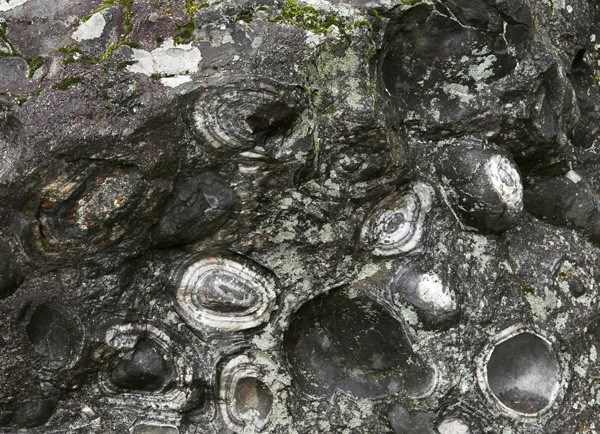
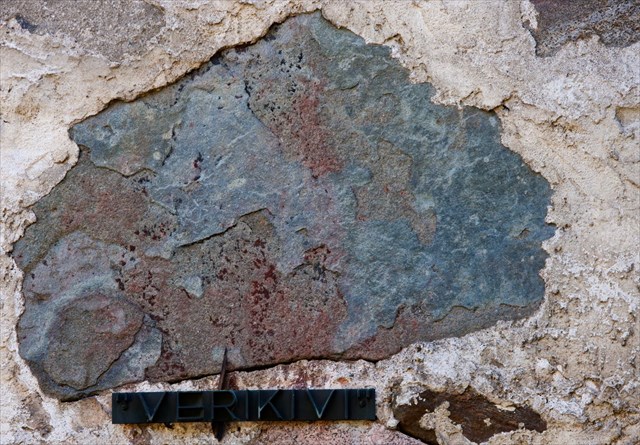
 Pallograniitti
Pallograniitti
(skip to English section.)
Magmakivet jaetaan kolmeen ryhmään muodostumistapansa perusteella. Syväkivilajit eli plutoniset kivilajit kiteytyvät kivisulasta eli magmasta hitaasti syvällä maankuoressa. Juonikivet syntyvät samalla tavoin, mutta kuoren ulkokerroksissa magmasäiliössä, kun taas tulivuoresta maan pinnalle purkautunut magma muodostaa vulkaanisia kivilajeja eli vulkaniitteja, joita kutsutaan yhteisellä nimellä myös eruptiivikiviksi tai pintakiviksi.
Syväkivi eli plutoninen kivilaji on intrusiivisesti Maan kuorikerrokseen muodostuneessa magmasäiliössä kuumasta kivisulasta eli magmasta jäähtynyt, karkearakeinen magmakivi. Syväkiville on ominaista suuret, faneriittiset, kiteet, jotka syntyvät magman jäähtyessä hitaasti, sekä rakenteen tiiviys; syväkivissä ei yleensä tavata kaasurakkuloita tai huokosia. Eroosion seurauksena syväkiviä tavataan yleisesti myös maan pinnalla varsinkin vanhassa, arkeeisessa ja proterotsooisessa kallioperässä. Syväkiviä ovat esimerkiksi graniitti, granodioriitti, syeniitti, dioriitti, gabro ja peridotiitti vähenevän kvartsimäärän mukaisessa järjestyksessä.
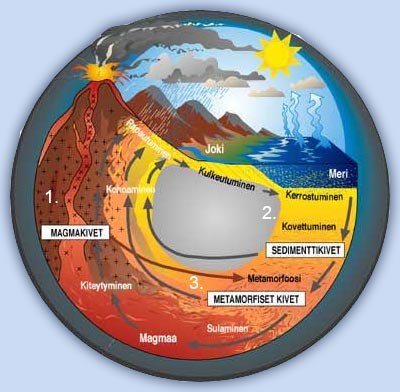
Kivien synty ja kiertokulku
Pallograniitti on Kivilaji, jossa tummat (biotiitti ja sarvivälke) ja vaaleat (maasälvät ja kvartsi) mineraalit muodostavat samankeskisiä kehiä, joskus palloja. Pallograniittien kehien (pallojen) koko vaihtelee. Pallograniitit ovat koostumukseltaan yleensä graniitteja tai granodioriitteja, joita on tavattu mm. Kurussa, Kangasalla, Espoossa, Porvoossa ja Kemijärvellä.
Pallokivi on nimitys syväkivestä, jolla on omalaatuinen pallokivirakenne. Tällaiseen kiveen on kehittynyt pallomaisia tai ellipsoidimaisia kivirakenteita. Pallokivien pallot ovat tyypillisesti konsentrisia, jolloin niissä vuorottelevat koostumukseltaan vaihtelevat kehät. Kivilajeja, joissa pallokivirakennetta saattaa esiintyä ovat muun muassa graniitti, gabro ja dioriitti. Pallokivien pallot muodostuvat magmasäiliössä kiinteiden kiteytymiskeskusken, tyypillisesti mineraalikiteen ympärille yhtäkkisen paineenlaskun seurauksena. Suomessa on monia tunnettua pallokiviesiintymiä, jotka ovat suurin osa maailman tunnetuista pallokiviesiintymistä. Syynä tähän ovat niin graniittivaltainen kallioperä kuin Suomen kallioperään kohdistunut perusteellinen tutkimustyö. Pallokivet soveltuvat kauniin ulkonäkönsä puolesta rakentamiseen ja kiviveistoksiin, mutta pallokiviesiintymien harvinaisuuden vuoksi nämä ovat Suomessa suojeltuja. Pallokivi on Pirkanmaan maakuntakivi.
Tyypillistä pallokivelle ovat pyöreät muodot, joita kutsutaan "orbiculeiksi" tai joskus vain "palloiksi". Nämä pallot vaihtelevat suuresti kooltaan ja koostumukseltaan. Jotkut näistä ovat pitkänomaisia johtuen kiven muodonmuutoksesta. Pallot muodostuvat ytimen ympäröimistä säteittäisesti kasvavista kiderenkaista. Ulompi osa on nimeltään "kuori". Joissain pallokivissä ovat vain yhden tyyppisiä kuoria, mutta useimmat kivet sisältävät runsaasti konsentrisia kuoria.
Ytimen koostumus voi olla usean eri tyyppinen:
- ryhmittäisiä pieniä kiteitä tai
- Yksi suuri kide (tai osia niistä), nimeltään "ydin" tai
- Xenoliittiä - eli paloja kallioperästä.
Seuraava kuva on peräisin:
Hans Peter Meyer: Zur Petrologie von Orbiculiten, (Karlsruhe 1989).
Kuvasta on tyypillinen orbiculen rakenne Kurun Pengonpohjan pallokivestä.
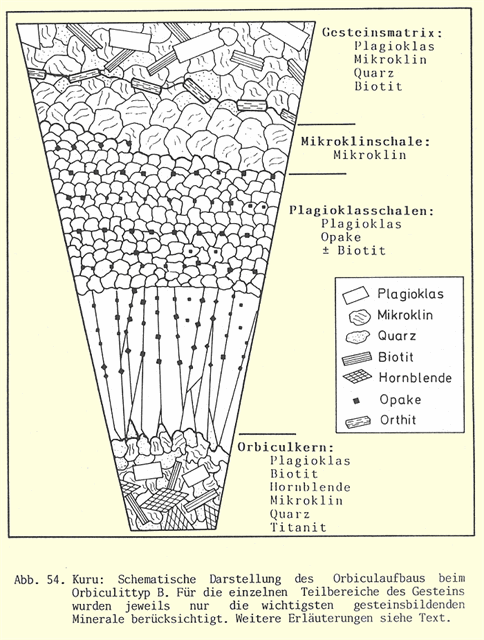 Kurun pallokiven pallokuvio, käännös:
Kurun pallokiven pallokuvio, käännös:
culkern=ydin, schale=kuori
Kuten edellä todettiin - pallokivet ovat harvinaisia. Yksi syy tähän on niiden esiintymien pieni koko. Lisäksi lähes kaikki pallokivet sijaitsevat muiden kivilajien sisällä. Keskimääräisesti tällaisen esiintymän koko on noin kymmenen neliömetriä, jonka pituus ja syvyys ovat noin 3-5 metriä. Isompiakin esiintymiä voi joskus löytyä, mutta ne ovat erittäin harvinaisia. Useimmat pallokivet ovat löytyneet irtonaisista lohkareista joiden alkuperä on tuntematon. Joissakin tapauksissa jopa intensiivinen alkuperäisen esiintymän etsintä on epäonnistinut.
(palaa alkuun)
 Raudan esiintyminen luonnossa
Raudan esiintyminen luonnossa
Rautaa esiintyy luonnossa vapaana meteoriittirautana. Maankuoressa sitä on kuitenkin paljon enemmän erilaisina yhdisteinä kuten magnetiittina, hematiittina ja rikkikiisuna. Se on neljänneksi yleisin alkuaine ja toiseksi yleisin metalli maankuoressa, jossa sitä on noin 5 prosenttia. Nykyisten geologisten teorioiden mukaan maapallon sisin osa sisältää etupäässä rautaa ja nikkeliä. Jos teoria pitää paikkansa, maapallolla on rautaa enemmän kuin mitään muuta alkuainetta, noin 35 prosenttia Maan massasta. Rautaoksidia on runsaasti myös Marsin pintakerroksissa, jotka saavat niistä punertavan värinsä.
Yleensä malmit ovat syntyneet vuorten poimuttuessa, kun kivilajit ovat sulaneet ja magma myöhemmin jäähtynyt ja jähmettynyt, jolloin magmapesäkkeen alaosaan ovat ensiksi eriytyneet ja näin pesäkkeet pohjalle vajonneet raskaat mineraalit, kuten kromiitti ja magnetiitti. Magmapesäkkeen yläosaan taas on kiteytynyt viimeiseksi muun muassa hopea-, kulta-, kupari-, lyijy- ja nikkelimalmeja. Näiden malmioiden välissä oleva kivi sen sijaan on vähemmän metallipitoisempaa. Malmiesiintymiä tunnetaan eniten vanhojen poimuvuoristojen alueella, missä malmiot ovat paljastuneet rapautumisen aiheuttaman kulutuksen seurauksena.
Vaikka rautaa on lähes kaikissa kivilajeissa, sen valmistamiseksi kannattaa yleensä louhia vain sellaisia malmeja, joissa sitä on vähintään 30 prosenttia. Magnetiitti on perinteinen rautaa sisältävä mineraali, jota on louhittu esimerkiksi Ruotsin Kiirunassa ja Pohjois-Amerikassa. Nykyisin suuri osa raudasta saadaan hematiitti esiintymistä, joissa louheen rautapitoisuus on noin 60 %. Raakarautaa valmistetaan rautaoksidi malmista hiilellä pelkistämällä masuuneissa. Yli puolet maailmassa käytetystä raudasta on tällä hetkellä kierrätettyä romurautaa, joka sulatetaan valokaariuuneissa jatkojalostusta varten. Kierrättäminen vähentää hiilidioksidipäästöjä ja veden kulutusta huomattavasti.
Rautamalmi on kiveä, josta kannattaa erottaa metallista rautaa. Rauta itse on yleensä oksideina eli joko magnetiittina (Fe3O4) tai hematiittina (Fe2O3). Puhtaat magnetiitti- tai hematiittiesiintymät alkavat olla jo lopussa, joten nykyisin louhitaan takoniitin tyyppisiä kivilajeja, joissa rautapitoisempi aines on sekoittuneena runsaaseen sivukiveen. Sen takia rautakaivokset tuottavat runsaasti jätemateriaalia, joka on moni paikoin ympäristöongelma.
(palaa alkuun)
 Kangasalan Kirkko ja Tapulinmäki
Kangasalan Kirkko ja Tapulinmäki
Kangasalan kirkko on 1760-luvulla rakennettu kivikirkko. Kirkko, joka on Antti Piimäsen rakentama, sijaitsee Kangasalan keskustassa Kirkkoharjun kupeessa. Kirkko otettiin käyttöön ilman tornia 1767, mutta lopullisesti kirkko torneineen valmistui syksyllä 1776. Kirkon torni kaatui vuonna 1782 ja uusi torni valmistui syksyllä 1800. Kirkossa on nykyään Kangasalan urkurakentamo Oy:n 1988 rakentamat 34-äänikertaiset urut kolmella sormiolla. Persoonallisena yksityiskohtana kirkon katto muodostuu sadoista raameissa olevista tähdistä. Kirkon vasemman takasivustan seinään on muurattu kivi, johon liittyy myös paikallinen legenda. Veripisarat Kangasalan vaakunassa symboloivat tätä legendaa.
Kangasalan tapulinmäellä sijaitsee kangasalan pirtti, seurakuntakoti ja kangasalan kotiseutumuseo. Museon edessä oleva kivi on harvinaista pallograniittia ja se on syntynyt 2000 milj. vuotta sitten. Sulaan kivimassaan on tippunut kiinteitä kiviä, joista on muodostunut kuppimaiset kolot ja pyöreät nystyrät. Siirtolohkare on tuotu v.1967 Kangasalan Haapaniemestä.
1830-luvulla kirkon ylijäämäkivistä rakennetussa kunnan viljamakasiinissa toimii Kangasala-Seuran ylläpitämä kotiseutumuseo. Aivan kauniin kivikirkon tuntumassa voit tutustua kivikautiseen Sarsa-keramiikkaan, nuolenpäihin ja muihin Kangasalan alueen kaivauslöytöihin. Museo on kuuluisa historiallisista henkilöryhmistään.
Museossa on n. 1700 luetteloitua esinettä, jotka on saatu lahjoituksina pitäjäläisiltä. Kokoelmaan kuuluu mm. Kesäpäivä Kangasalla -laulun säveltäjän Gabriel Linsenin taffelipiano. Kotiseutumuseossa esitellään myös kirjailija, teatterimies ja sukututkija Jalmari Finnen henkilökohtaista jäämistöä ja julkaisuja. Museossa järjestetään myös vaihtuvia näyttelyitä, jotka liittyvät Kangasalan historiaan.
(palaa alkuun)
 Jotta voit merkitä logatuksi tämän kätkön sinun
Jotta voit merkitä logatuksi tämän kätkön sinun
täytyy suorittaa seuraavat tehtävät annetuissa koordinaateissa:
1 )
Tämän kätkön koordinaatit sijaitsevat Kangasalan kotiseutumuseon edustalla. Museon vieressä on nähtävillä kimpale pallograniittia.
a) Kuinka monta pallokiviesiintymää tunnetaan Suomessa?
b) Mikä osuus maailman pallokiviesiintymistä sijaitsee Suomessa?
c) Kuvaile pallokivien erityispiirteitä kuten kiven kokoa ja koostumusta. Perusta kuvauksesi siihen, mitä näet paikan päällä.
d) Mittaa tai arvioi isoimman ja pienimmän kivessä näkemäsi pallon halkaisija.
2 )
referenssipisteessä GC3R3NK, Verikivi - Bloodstone N 61° 27.822 E 024° 04.222 on nähtävillä kirkon seinään muurattu kivi. Legendan mukaan kivi itkee verta. (hyppää waypointteihin).
a) (vapaaehtoinen tehtävä liittyen kansantarustoon) Kerro pääkohdat kiveen liittyvästä legendasta.
b) selvitä myös mikä on tieteellinen selitys kiven "itkemiselle". vinkki: Kirkon seinässä oleva kivi EI ole Hematiittia, älä siis kopioi googlen tekstiä hakusanasta "verikivi".
3 )
Lähetä vastauksesi kätkön omistajalle vaikkapa tällä viestilinkillä.
Kirjoita viestin otsikoksi Pallograniitti, Kangasala
(ps. jos laitat viestin alla valinnan "I want to send my email address along with this message." vastamminen helpottuu.)
4 )
Sinun ei tarvitse odottaa loggauslupaa, mutta asiattomat logit tullaan poistamaan. Omistaja vastaa jollain aikavälillä viestiin jos vastauksissa on epäselvää.
5 )
Toivottavaa mutta ei pakollista on myös että otat valokuvan itsestäsi ja/tai gps laitteestasi pallokiven ja/tai verikiven lähellä ja liität se logiisi.
(palaa alkuun)
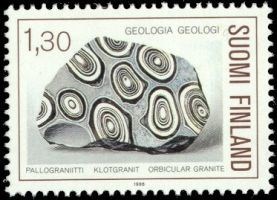
 Orbicular rock
Orbicular rock
Magma (from Greek μάγμα "mixture") is a mixture of molten or semi molten rock, volatiles and solids that is found beneath the surface of the Earth, and is expected to exist on other terrestrial planets. Besides molten rock, magma may also contain suspended crystals and dissolved gas and sometimes also gas bubbles. Magma often collects in magma chambers that may feed a volcano or turn into a pluton. Magma is capable of intrusion into adjacent rocks, extrusion onto the surface as lava, and explosive ejection as tephra to form pyroclastic rock. Magma is a complex high-temperature fluid substance. Temperatures of most magmas are in the range 700 °C to 1300 °C (or 1300 °F to 2400 °F), but very rare carbonatite melts may be as cool as 600 °C, and komatiite melts may have been as hot as 1600 °C. Most are silicate mixtures. Environments of magma formation and compositions are commonly correlated. Environments include subduction zones, continental rift zones, mid-ocean ridges and hot spots. Despite being found in such widespread locales, the bulk of the Earth's crust and mantle is not molten. Rather, most of the Earth takes the form of a rheid, a form of solid that can move or deform under pressure. Magma, as liquid, preferentially forms in high temperature, low pressure environments within several kilometers of the Earth's surface. Magma compositions may evolve after formation by fractional crystallization, contamination, and magma mixing. By definition rock formed of solidified magma is called igneous rock. While the study of magma has historically relied on observing magma in the form of lava outflows, magma has been encountered in situ three times during drilling projects—twice in Iceland, and once in Hawaii.
A pluton in geology is a body of intrusive igneous rock (called a plutonic rock) that crystallized from magma slowly cooling below the surface of the Earth. Plutons include batholiths, stocks, dikes, sills, laccoliths, lopoliths, and other igneous bodies. In practice, "pluton" usually refers to a distinctive mass of igneous rock, typically several kilometers in dimension, without a tabular shape like those of dikes and sills. Batholiths commonly are aggregations of plutons. Examples of plutons include Cardinal Peak and Mount Kinabalu. The most common rock types in plutons are granite, granodiorite, tonalite, monzonite, and quartz diorite. Generally light colored, coarse-grained plutons of these compositions are referred to as granitoids.

Birth of rocks ,key:
magmakivet=igneous rocks, sedimenttikivet=sedimentary rocks, metamorfiset kivet=metamorphic rocks, kiteytyminen=crystallization, kulkeutuminen=diversion, kerrostuminen=sedimentation, kovettuminen=hardening, rapautuminen=erosion, kohoaminen=rising
Orbicular granite (also known as orbicular rock or orbiculite) is an uncommon plutonic rock type which is usually granitic in composition. These rocks have a unique appearance due to orbicules - concentrically layered, spheroidal structures, probably formed through nucleation around a grain in a cooling magma chamber. Almost one third of known orbicular rock occurrences are from Finland. The occurrences are usually very small.
Orbicular rocks are a rare variety of magmatic rocks. Orbicular rocks occur in different types of rocks, such as granite, gabbro and diorite. Most of them are composed of the same minerals as lots of plutonic rocks: K-feldspar and plagioclase, quartz, dark minerals like hornblende and biotite and some other minerals. The typical features of orbicular rocks are round bodies, called "orbicules". These orbicules show a wide variation in size and composition. Some of them are elongated due to deformation. All of the orbicular rocks contain a core in the middle surrounded by radially grown crystals. The outer part of an orbicule shows concentric lines - called "shells". Some rocks have only got one single shell, but most of the rocks contain a lot of concentric shells. Orbicular rocks are probably formed through nucleation around a grain in a cooling magma chamber.
The typical features of orbicular rocks are round bodies, called "orbicules" or sometimes just "orbs". These orbicules show a wide variation in size and composition. Some of them are elongated due to deformation. All of them contain a core in the middle surrounded by radially grown crystals. The outer part of an orbicule shows concentric lines - called "shells". Some rocks have only got one single shell, but most of the rocks contain a lot of concentric shells.
The composition of the cores can be quite different:
- Cluster of small crystals or
- single large crystals (or pieces of them), called "nucleus" or
- Xenoliths – pieces of the host rock.
These cores are always surrounded by radially grown minerals with a transition to the shells. These shells are composed of different layers of crystals. Some layers are of radially grown crystals (often plagioclase), some are tangential and others are composed just of small grains without any orientation. The visible drawing of the shells - concentric lines - does not always correspond with the mineral texture, which can be seen in thin sections.
The following scheme is from:
Hans Peter Meyer: Zur Petrologie von Orbiculiten, (Karlsruhe 1989). The drawing shows the typical texture of an orbicule from Pengonpohja/Kuru. The Orbicul is dominated by shells that show different ways of texture.

texture of Orbicule ,key:
culkern=core, schale=shell
If the core consists of an agglomeration of small mineral grains, the beginning of the radial growth is hard to see, sometimes the transition is not visible at all. The first visible line above the core that follows the shape of the orbicule, is often the outer rim of the inner shell.
As said above – orbicular rocks are rare. One reason for that is the tiny size of their occurences. Nearly all orbicular rocks are located at small dykes and lenses at the margin of magmatic intrusions. The average size of such an occurence is about some ten meters (!) in length and 3-5 meters in width. Bigger outcrops may be found but they are extremely rare. On the other hand a couple of very little occurrences is known and some of them are smaller than 5 meters in diameter. Most of the orbicular rocks found are boulders of unknown origin. In some cases even intensive search failed. One of the most beautiful rocks is only known from boulders. Several attemps were made to find the outcrop – without success.
(skip to beginning)
 Iron in nature
Iron in nature
Iron is an abundant element in the universe; it is found in many stars, including the sun. Iron is the fourth most abundant element in the earth's crust, of which it constitutes about 5% by weight, and is believed to be the major component of the earth's core. Iron is found distributed in the soil in low concentrations and is found dissolved in groundwaters and the ocean to a limited extent. It is rarely found uncombined in nature except in meteorites, but iron ores and minerals are abundant and widely distributed.
An ore is a type of rock that contains minerals with important elements including metals. The ores are extracted through mining; these are then refined to extract the valuable elements. The grade or concentration of an ore mineral, or metal, as well as its form of occurrence, will directly affect the costs associated with mining the ore. The cost of extraction must thus be weighed against the metal value contained in the rock to determine what ore can be processed and what ore is of too low a grade to be worth mining. Metal ores are generally oxides, sulfides, silicates, or "native" metals (such as native copper) that are not commonly concentrated in the Earth's crust or "noble" metals (not usually forming compounds) such as gold. The ores must be processed to extract the metals of interest from the waste rock and from the ore minerals. Ore bodies are formed by a variety of geological processes. The process of ore formation is called ore genesis. Iron ores are overwhelmingly derived from ancient sediments known as banded iron formations . These sediments are composed of iron oxide minerals deposited on the sea floor. Particular environmental conditions are needed to transport enough iron in sea water to form these deposits, such as acidic and oxygen-poor atmospheres within the Proterozoic Era.
Iron ores are rocks and minerals from which metallic iron can be economically extracted. The ores are usually rich in iron oxides and vary in color from dark grey, bright yellow, deep purple, to rusty red. The iron itself is usually found in the form of magnetite (Fe3O4), hematite (Fe2O3), goethite (FeO(OH)), limonite (FeO(OH).n(H2O)) or siderite (FeCO3). Ores carrying very high quantities of hematite or magnetite (greater than ~60% iron) are known as "natural ore" or "direct shipping ore", meaning they can be fed directly into iron-making blast furnaces. Most reserves of such ore have now been depleted. Iron ore is the raw material used to make pig iron, which is one of the main raw materials to make steel. 98% of the mined iron ore is used to make steel. Indeed, it has been argued that iron ore is "more integral to the global economy than any other commodity, except perhaps oil.
(skip to beginning)
 Kangasala church and hill Tapulinmäki
Kangasala church and hill Tapulinmäki
With its ridges and lakes, Kangasala is the place to get to know important people, even a queen. The Kangasala Local History Museum is housed in a parish granary from the 1830s, located opposite the church on the hill Tapulinmäki. In addition to traditional rustic artefacts, the Kangasala Local History Museum showcases artefacts that used to belong to author Jalmari Finne. The more special items at the museum are groups of historical mannequins. Among them is the royal Kaarin Månsdotter. In addition, the museum hosts changing exhibitions on themes related to Kangasala. Guests can also visit a small shop.
In front of the museum there is a boulder of orbicular stone which is imported from v.1967 from Kangasala Haapaniemi.
It is fairly easy to move about on the ground floor of the museum, but access to the first and second floor is via a narrow staircase. Near the museum, you can find Kangasala Church, built in the 1760s. A few kilometres from the Kangasala Local History Museum is the Kangasala Rest Home, which houses a handicraft shop in summertime.
There are two significant churches in Kangasala. The handsome grey granite church with its beautiful baroque star ceiling, built in 1767, is located in the middle of the parish village. Its rare wooden sculptures, dating back to the 15th century, make the church particularly fascinating. During the summer months the church is open daily, and guided tours are available. In the wall of church there is a stone that according to legend "bleeds blood".
(skip to beginning)

 To log this cache you must do following tasks in given coordinates:
To log this cache you must do following tasks in given coordinates:
1 )
The coordinates of this cache are in front of Kangasala Local History Museum. Near museum you can find block of orbicular stone.
a) How many orbicular rock sites are known to exist in Finland?
b) What percentage of world's orbicular rock sites are in Finland?
c) Describe the specifics of orbicular rocks, e.g., the size and of orbs and their composition. Base your description on what you see at the site.
d) measure the diameter of the biggest and the smalles orb you can find out in the surface of this stone.
2 )
Go to the reference point, GC3R3NK verikivi - blood stone at N 61° 27.822 E 024° 04.222. There you can see a famous "blood stone" in the north wall of church. It slowly leaks a reddish, bloodlike substance.
(skip to waypoints).
a) (optional task about folklore) Find out and tell main points about the legend that is associated with this stone.
b) Also explain what is scientifical explanation for the "bleeding".
3 )
Send your answers (for example via this message link) to the cache owner.
Title your post “Pallograniitti, Kangasala”
(ps. if you enable selction "I want to send my email address along with this message" it is easier for me to reply)
4 )
You don't have to wait for a logging permission, but any incomplete logs will be deleted. Cache owner will reply something for post if there is some faults in answers.
5 )
Is also desirable altough totally optional that you take a photo of yourself and/or your GPS device on the side of orbicular rock, and/or "blood stone" and attach it to you log.
(skip to beginning)
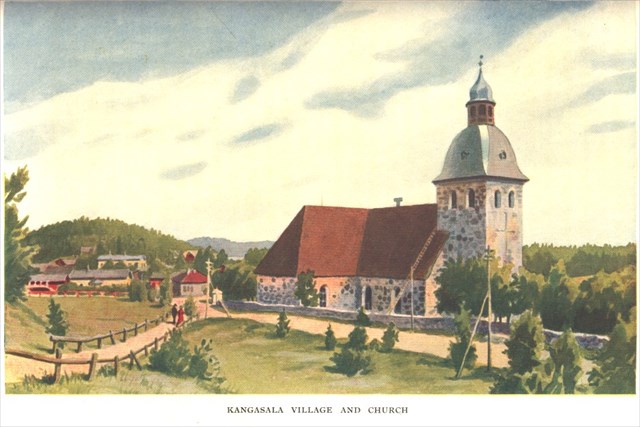
you can also contact cache owner via facebook:

Additional Hints
(No hints available.)